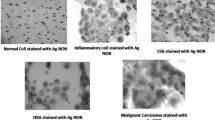Abstract
Nucleolar organizer regions (NORs) were studied in surgically removed specimens from 76 patients with squamous cell carcinomas of the larynx using an argyrophilic (Ag) staining technique. The mean number of AgNORs per nucleus was 4.3±1.38 (SD). The mean AgNOR number for T1 or T2 disease was statistically lower than that for T3 or T4 lesions (P<0.05). The mean AgNOR number was lower in patients with N0 disease than in patients with N1 or N2 or N3 tumors (P<0.05). There was also a statistically significant difference between the mean AgNOR number for stage II and stage III disease (P<0.01), for stage III and stage IV disease (P<0.05), but not for stage I and stage II disease. According to the histological grading, there was a significant difference between the mean AgNOR number for the well-differentiated and moderately differentiated tumors (P<0.05), and for the moderately differentiated and poorly differentiated types (P<0.01). These results suggest that the number of AgNORs in the nucleus is a significant indicator of laryngeal carcinomas.
Similar content being viewed by others
References
Crocker J, McGovern J (1988) Nucleolar organizer regions in normal, cirrhotic and carcinomatous liver. J Clin Pathol (Lond) 41:1044–1048
Crocker J, Nar P (1987) Nucleolar organizer regions in lymph nodes. J Pathol 151:111–119
Fakan S, Hernandez-Verdun D (1986) The nucleolus and the nucleolar organizer regions (collected review) Biol Cell 56:189–206
Fallonfield ME, Dodson AR, Cook MG (1988) Nucleolar organizer regions in melanocytic dysplasia and melanoma. Histopathology 13:95–99
Giri DD, Nottingham JF, Laery J, Dundas SAC, Underwood JCE (1989) Silver-binding nucleolar organizer regions (AgNORs) in benign and malignant breast lesions: correlations with ploidy and growth phase by cytometry. J Pathol 157:307–313
Hermanek P (1986) Problems of pTNM classification of carcinoma of the stomach, colorectum and anal region. Pathol Res Pract 181:296–300
Hermanek P, Sobin LH (1987) International Union Against Cancer. TNM classification of malignant tumors, 4th eds. Springer, New York, pp 13–36
Jordan G (1987) At the heart of the nucleus. Nature 329:489–490
Kaneko S, Ishida T, Sugio K, Yokohama H, Sugimachi K (1991) Nucleolar organizer regions as a prognostic indicator for stage I non-small cell lung cancer. Cancer Res 51:4008–4011
Kaplan EL, Meier P (1958) Non-parametric estimation from incomplete observation. J Am Stat Assoc 53:457–481
Morita M, Kuwano H, Matsuda H, Moriguchi S, Sugimachi K (1991) Prognostic significance of argyrophilic nucleolar organizer regions in esophageal carcinoma. Cancer Res 51:5339–5341
Nakashima T, Yano G, Hayashi I, Katsuta Y (1992) Evaluation of epithelial membrane antigen and S-100 protein labeled cells in primary and metastatic laryngeal carcinomas. Head Neck 14:445–451
Ofner D, Tosch M, Sandbichler P, Hallbrucker CHR, Margreiter R, Mikuz G, Smith KW (1990) Silver stained nucleolar organizer region proteins (AgNORs) as a predictor of prognosis in colonic cancer. J Pathol 162:43–49
Ogura S, Abe S, Sudoh NK, Kurikane H, Nakajima I, Inokue K, Kawakami Y (1992) Correlation between nucleolar organizer regions visualized by silver staining and the growth rate in lung adenocarcinoma. Cancer 70:63–68
Pera E, Moreno A, Galindo L (1986) Prognostic factors in laryngeal carcinoma: a multifactorial study of 416 cases. Cancer 58:928–934
Ploton D, Menegar M, Jeannesson P, Himber G, Pigeon F, Adnett JJ (1986) Improvement in the staining and in the visualization of argyrophilic proteins of the nucleolar organizer region at the optic level. Histochem J 18:5–14
Smith R, Crocker J (1988) Evaluation of nucleolar organizer region-associated proteins in brest malignancy. Histopathology 12:113–121
Author information
Authors and Affiliations
Rights and permissions
About this article
Cite this article
Nakashima, T., Yano, G., Masuda, A. et al. Argyrophilic nucleolar organizer regions as a prognostic indicator of laryngeal carcinomas. Eur Arch Otorhinolaryngol 251 (Suppl 1), S76–S79 (1994). https://doi.org/10.1007/BF02565226
Received:
Issue Date:
DOI: https://doi.org/10.1007/BF02565226



